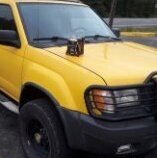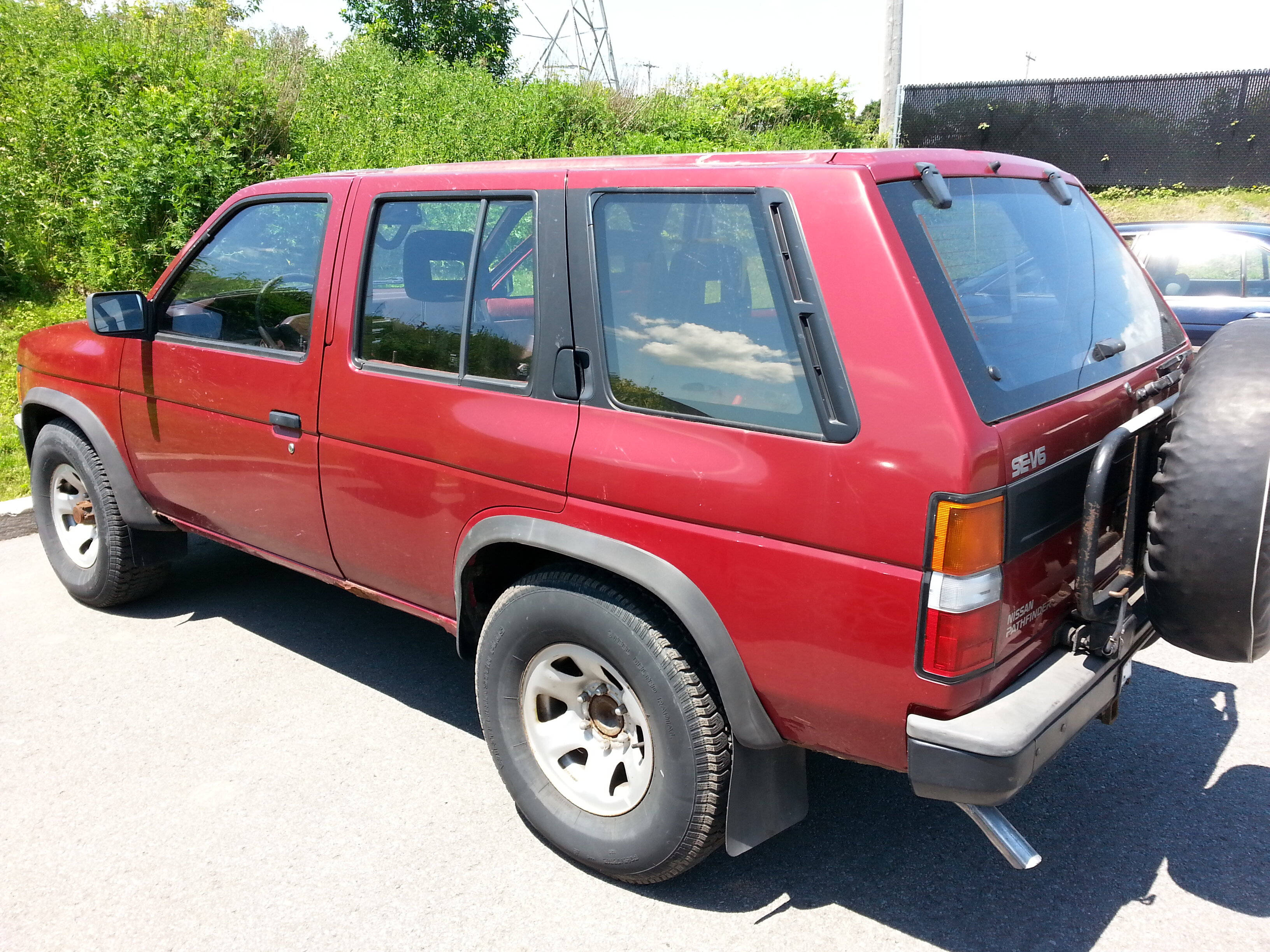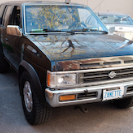-
Posts
1,055 -
Joined
-
Last visited
-
Days Won
6
Content Type
Profiles
Forums
Calendar
Everything posted by SpecialWarr
-
Looking for a new career? Anyone want to trade for a bicycle mechanic? No?... didn't think so. *sigh*
-

Max Horsepower Rating Stock Engine Internals
SpecialWarr replied to SquadCarPathfinder's topic in 90-95 WD21 Pathfinders
I was under the impression that the long blocks were identical between the Z31 and the WD21, the intake, and all other accessories were quite different but some people have gotten some serious horsepower out of these engines at the cost of reliability. for one: but that engine gets rebuilt or blown up often. for two : Both of these guys are running some serious boost into their turbos so you know that's hard on a car's internals. So no... they are not going to last a long time at that kind of output. If you want power you _have_ to sacrifice reliability OR money (mostly both). That's my two cents worth so take that for an internet opinion but I have a fairly fresh motor _when_ you need one.... it's not cheap though... and shipping isn't free! LOL!! -
Both of those front trailing arms are supposed to be straight as an arrow. I have no idea how you do that to a cast steel piece but I would bet an attempt to remove the truck from where it was stuck was the culprit. I'm pretty sure those are only on the early WD21s (my '90 has them) and suspect that they are on up to 1992/93 when they started making changes (round dash models). Don't bother trying to straighten that though, you'll need to bring the piece up to at least cherry red (preferably orange) before it will even move, at that temperature the bushings will be on fire (press-in bushings) and you need to have an alignment bar to make sure that she's beyond straight by 3 degrees and comes back to straight once it cools. 1/8" out won't kill you but it's going to be tough to get the bolt in and threaded! Once you've done that the thing is going to need to be tempered in an oven a 200 degrees C. for about an hour. Then you need to install new / used and good bushings at both ends.
-
The coil can put out about 35-38000 volts (one of the highest in a regular truck ) so good wires and excellent grounds are needed to make sure that gets through the plugs. I highly recommend using the dielectric grease that comes with the wires on both ends! It helps! Plugs can be almost any in the right heat range, length and projection. Dirt cheap Champion all the way to Bosch iridium will make virtually no difference. I like the Bosch and NGK because they are easy to find albeit pricy. But for $35 for 6 plugs the Champions are tough to beat! A touch of anti-seize on the threads and good to go!
-
Well since everything is attached, new and good-ish then the only thing left to check is every single grounding point in the engine bay. I sanded and cleaned every point where a cable was attached to the body so that should work for you. You have to remove every cable and sand and clean the ends, sand and clean the body down to the metal and reattach the cable ends where they come from. Then you can be sure that your electrical connections are not the problem. If that don't work: y'all need to take that to a electrical specialist!
-
You may also want to take a multi-meter to the fusible links to see if voltage is running through them ( most people just ignore them until nothing works ). tapping the relays may also help but won't fix anything, just point you in a direction. As in any electrical system (on a car) start at the battery, then test the thickest wires leading away from the battery, then test the grounds to the body, motor and starter in that order. The tests should be for voltage first and _after_ you remove the battery post connectors, for resistance. Voltage should read battery voltage to the tenth of a volt everywhere you test, resistance should be 00.00 to 00.03 from one end of a cable to the other. Don't forget to wiggle stuff and re-measure. Keep doing that for every smaller wire in the system shown in the FSM (download from nicoclub.com ). Once you get better at doing this you'll be able to take some shortcuts. UNTIL you get better at diagnostics, stick with this method as it is _infallible_ for finding the problem.
-
Nice work man!! I understand the feeling of awesomeness that you experience when you get everything back together; it is E.P.I.C. Again, congratulations!!
-
I miss my pathfinder....and now my Xterra is eating wheel bearings. *sigh* when does it end?
-
Your 13v reading was with a digital multi-meter? And at the two posts _on_ the battery, not on the clamp, right? If both of those are right then I would suspect that the alternator's voltage regulator is on it's way out. Take a look for the '94 Maxima alternator or the one for a Nissan Quest / Mercury Villager, they tend to be considerably less expensive than the ones of the Pathfinder. Your battery shouldn't ever read anything below 12.2v IF everything is working as it is supposed to but WORD TO THE WISE: get a second multi-meter to make sure the the first meter is reading correctly. I had to learn that one the hard way and spent $$$$$$ on a new alt, a new battery, and a new starter. A $30 mechanical multi-meter is waaaay cheaper than a $150 alternator.
-

Rough Idle on occasional longer start
SpecialWarr replied to SquadCarPathfinder's topic in 90-95 WD21 Pathfinders
I can see how a missing knock sensor could cause a rough idle and throw the money light on.... it just plugs in behind the intake but if you have large hands and little dexterity it's going to be a struggle. You have to remove the upper intake plenum to even get to the knock sensor. -

Lots of white smoke from exhaust in the morning
SpecialWarr replied to calvinM's topic in 90-95 WD21 Pathfinders
What the man sayz ^^ -

Rough Idle on occasional longer start
SpecialWarr replied to SquadCarPathfinder's topic in 90-95 WD21 Pathfinders
I would think that a cracked exhaust stud or a clogged MAF sensor might do that but thinking about it while I write this another thought occurred to me: does the MAF itself have a good ground, i.e.: a new ground wire to bare metal? If not there is a new part that (used to be available) is supposed to add a wire to that connector. There are a few threads in here that speak to that subject including part numbers and how-tos. -

Lots of white smoke from exhaust in the morning
SpecialWarr replied to calvinM's topic in 90-95 WD21 Pathfinders
Now is that whispy, thin white smoke or crap-tons of white smoke that you _can't_ see through?? If it's the first kind it may just be accumulated water condensation in the exhaust and resonator, nothing to see here. IF it's the latter: the head gasket may be done and is leaking coolant into the exhaust headers. The only two realistic probabilities are water from outside getting in and water from inside getting out. Are you sure that you aren't loosing coolant? Visual check or measured volume? -
This is from smj999smj over on the nico club forums: According to the wiring diagram, there are two, BLACK/WHITE wires at the fuel pump relayharness connector which are powered by a single, 10A fuse. So, if you unplug the fuel pump relay, you should confirm power at those two wires with a 12v test light with the key in "ON" or "START" positions. The fuel pump relay harness connector has two more wires: WHITE/BLUE and RED/BLUE. The RED/BLUE wire is part of the ground circuit for the fuel pump relay's solenoid(which is inside of the relay). When the relay is energized, it causes the switch side of the relay to close and send power to the fuel pump and the IACV air regulator. The RED/BLUE wire goes from the fuel pump relay harness connector to ECM pin #104 ; it is the ECM that provides the ground to this circuit. So, with the ECM and fuel pump relay disconnected, you should have no continuity between chassis ground and the RED/BLUE wire (if it does, then it is shorted). You should also have good continuity through the RED/BLUE wire with no excessive resistance when testing from the relay harness connector to the #104 pin of the ECM harness connector. Also, ECM harness connector pin #115 , a BLACK wire, should have good continuity to ground as it is the ground for the ECM. The WHITE/BLUE wire at the fuel pump harness connector starts as a single wire then splices (probably the reason why the wire is smaller at the pump connector), one to the IACV air regulator, which powers the air regulator and goes to ground. The other side of the splice goes to the fuel pump, where it powers the pump and goes to ground. If you jump a BLACK/WHITE wireto the WHITE/BLUE wire and the key is "on," you should have power to the fuel pump. If you don't, you have an open circuit in the WHITE/BLUE wire and it needs to be traced and repaired (I would also check for power at the IACV air regulator if there is no power at the pump because it may help out in the diagnosis of the open and tracing it). If you do have power to the pump when you jumped the relay, remove the jump wire and install a known good relay. If that doesn't fix it, it would be likely that the driver is bad inside the ECM and the ECM needs to be replaced.
-

Connection box on positive terminal cable
SpecialWarr replied to Charlie_Brown's topic in 90-95 WD21 Pathfinders
Photos? Link? -
That is most likely the two high pressure fuel hoses that run between the left and right bank of your fuel injectors. They aren't difficult to replace but it is an involved process of removing the upper portion of the intake, the throttle body, small items items (IACV, throttle position sensor, and the fuel pressure regulator). The hoses them selves aren't easy to get on since they are only 4 inches long and you don't have a lot of room to work them into position. but it _is_ do-able. There should be a write-up over in the Garage section, other wise they _must_ be a post about that elsewhere on the forum!
-
I would note that you do have to take the fender windshield cowl off to get to the last upper fender bolt ( for changing the fender) but if you get the rest of the bolts off them you should be able to swing the fender up and get a shoulder under there to unbolt the door hinges... and yes... it is not fun to fish the damn electrical back through the body but that's easier with a small wire and lots of electrical tape. ( I used a bicycle cable end because I had one handy. I just knotted one end and passed that behind the plug and tape the wires together to hold it in place-ish then kept taping the rest of the plug until it was sort of tapered with most of the wire poking out.... stuff that through the body and pull the tape off.)
-
"It appears that it is running from Transmission into cooler line on bottom of radiator coming from other cooler line bottom of radiator into B & M cooler & out from B & M cooler into other transmission line going back into transmission again. Not sure if they have it run correctly" That sounds like the way it is supposed to be run since there are the 2 hardlines bolted to the passenger side engine block that run from there across to the rad through reduced diameter flexible lines. I ran mine under the rad but beside the rad is fine as long as the rad itself is bypassed completely. I would be doing a tour under the truck with every possible socket snugging up every nut and bolt under there as a precaution paying _careful_ attention to _anything_ that was loose or not as tight as every other identical nut / bolt. After that I would start with the radiator fluid.... is it full and flowing with the rad cap off? It should be! Throw the cap back on and let it warm up then check the trans fluid... is it red and full? It should be! Other than that I would give the two hoses into the heater core back by the firewall and behind the valve cover vent a tug and wiggle with a pair of pliers (they'll be warm by now) to see if anything is loose or a clamp has come off or slipped. That's about all I can offer from 3000 miles away! Good luck!
-
Looking at the alignment and x,y,z coordinates in the FSMs it would be a crap-ton of fabricating mounts and adapters.... almost none of the points line up and heights and positions are all over the place. It might be possible but only if you can work on it on a flat floor, indoors somewhere. That is still beyond what I am willing to do.
-

Full size spare rim smaller than the rest of my wheels
SpecialWarr replied to Backpacker's topic in 86.5-89 WD21 Pathfinders
The spare was matched to the XE which came with 235/75 R15s and since all vehicles came with a spare on a steel rim it is considerably less expensive to specify a wheel and tire combo you already have in stock than spec something else. ANNNND you can charge a premium for a matching alloy rim as a spare! Sent from my SM-G386W using Tapatalk -

1st generation pathfinder starting problems
SpecialWarr replied to mrspeedk's topic in 90-95 WD21 Pathfinders
Might I suggest a bit of highlighting in the middle, a couple of pagebreaks and request that Precise1 or another administrator pin this in the Garage section. -

What are the typical causes for fan clutch failure?
SpecialWarr replied to MrEviLDeD's topic in 90-95 WD21 Pathfinders
You can rebuild it if you're feeling that good and have time:



